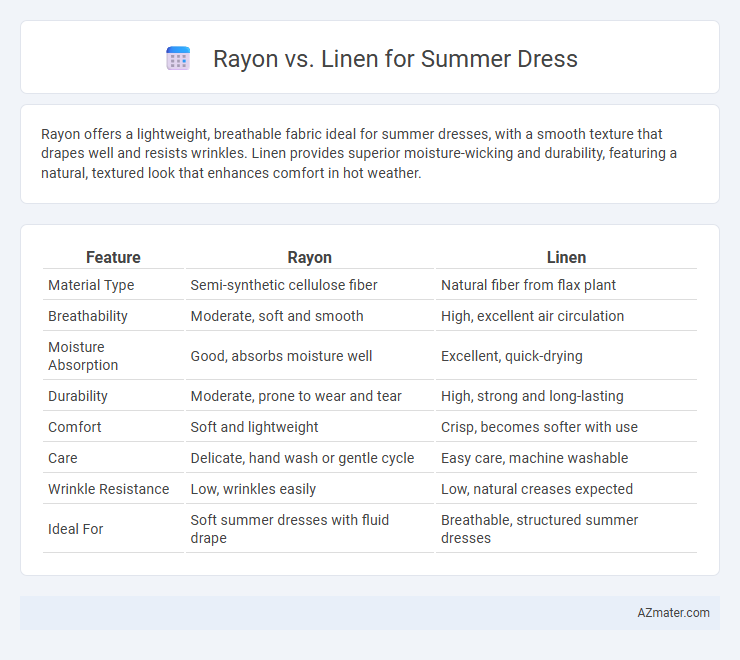Rayon offers a lightweight, breathable fabric ideal for summer dresses, with a smooth texture that drapes well and resists wrinkles. Linen provides superior moisture-wicking and durability, featuring a natural, textured look that enhances comfort in hot weather.
Table of Comparison
| Feature | Rayon | Linen |
|---|---|---|
| Material Type | Semi-synthetic cellulose fiber | Natural fiber from flax plant |
| Breathability | Moderate, soft and smooth | High, excellent air circulation |
| Moisture Absorption | Good, absorbs moisture well | Excellent, quick-drying |
| Durability | Moderate, prone to wear and tear | High, strong and long-lasting |
| Comfort | Soft and lightweight | Crisp, becomes softer with use |
| Care | Delicate, hand wash or gentle cycle | Easy care, machine washable |
| Wrinkle Resistance | Low, wrinkles easily | Low, natural creases expected |
| Ideal For | Soft summer dresses with fluid drape | Breathable, structured summer dresses |
Introduction: Why Choose Between Rayon and Linen for Summer Dresses
Rayon and linen both offer excellent breathability and moisture-wicking properties ideal for summer dresses, ensuring comfort in hot weather. Linen's natural fiber provides durability and a crisp texture, while rayon's smooth, lightweight fabric drapes elegantly. Choosing between these materials depends on preferences for fabric feel, maintenance, and style versatility in summer wardrobes.
Fabric Composition: What is Rayon? What is Linen?
Rayon is a semi-synthetic fiber made from regenerated cellulose derived primarily from wood pulp, offering a smooth, breathable texture ideal for summer dresses. Linen is a natural fiber obtained from the flax plant, renowned for its lightweight, moisture-wicking properties and durability in hot weather. While rayon provides softness and drape, linen offers enhanced breathability and a crisp, textured feel suitable for warm climates.
Breathability and Comfort in Hot Weather
Rayon, a semi-synthetic fiber, offers excellent breathability by wicking moisture away from the skin, making it suitable for hot weather yet less durable compared to natural fibers. Linen, derived from flax plants, provides superior airflow and quick-drying properties, enhancing comfort in summer dress fabrics with its natural texture. Both fabrics prioritize breathability and comfort, but linen's natural cooling ability often makes it the preferred choice for intense heat.
Moisture-Wicking and Absorbency Comparison
Rayon offers excellent moisture-wicking properties, quickly drawing sweat away from the skin to keep you cool and dry during hot summer days. Linen, made from flax fibers, boasts superior absorbency, efficiently soaking up moisture while allowing it to evaporate rapidly, enhancing breathability. Both fabrics provide effective moisture management, but rayon excels at moisture-wicking, whereas linen leads in overall absorbency and airflow.
Weight and Drape: Which Flows Better?
Rayon, known for its lightweight and smooth texture, offers excellent drape that flows gracefully, making it ideal for summer dresses that require fluid movement and a soft silhouette. Linen, while breathable and light, has a stiffer, more textured feel that results in a less flexible drape, often creating a structured look rather than a flowing one. Choosing rayon over linen for a summer dress enhances comfort through better weight distribution and superior fabric fluidity, especially in hot weather.
Durability and Longevity of Rayon vs Linen
Linen boasts exceptional durability due to its natural flax fibers, offering superior strength and resistance to wear that often improves with washing, making it ideal for long-lasting summer dresses. Rayon, a semi-synthetic cellulose fiber, provides a softer feel but tends to have lower tensile strength and can degrade faster with frequent washing and exposure to moisture. Choosing linen ensures a longer lifespan and consistent durability for summer garments, especially in hot, humid conditions where fabric resilience is crucial.
Care and Maintenance: Washing and Ironing Tips
Rayon dresses require gentle hand washing or machine washing on a delicate cycle with cold water to prevent shrinking and fabric damage, while linen can typically withstand machine washing in warm water but benefits from air drying to maintain its texture. Ironing rayon demands low heat settings and the use of a pressing cloth to avoid scorching, whereas linen can handle higher heat levels and steam to smooth wrinkles effectively. Proper care for both fabrics involves avoiding bleach and harsh detergents to extend the life and appearance of summer dresses.
Eco-Friendly Factors: Sustainability of Rayon vs Linen
Linen is derived from flax plants, which require less water and fewer pesticides, making it a more sustainable and eco-friendly fabric compared to rayon, which is produced from chemically processed wood pulp and involves energy-intensive manufacturing. Linen is biodegradable and durable, contributing to a lower environmental footprint throughout its lifecycle. Rayon production often results in deforestation and chemical waste, posing greater ecological challenges despite being breathable and lightweight like linen.
Style Versatility and Color Choices
Rayon offers exceptional style versatility for summer dresses, featuring a smooth texture that drapes well and adapts effortlessly to various cuts and patterns, making it ideal for both casual and formal wear. Linen, known for its natural, breathable fibers, provides a crisp, textured look that is perfect for relaxed, airy summer outfits but tends to have a more limited range of color saturation due to its fabric composition. Color choices in rayon are typically broader and more vibrant, thanks to its synthetic processing, while linen's palette leans toward soft, muted earth tones that highlight its organic aesthetic.
Which is Best for You? Final Thoughts on Rayon vs Linen for Summer Dresses
Rayon offers a smooth, lightweight feel with excellent breathability, making it ideal for those seeking a soft, flowy summer dress. Linen is highly durable, moisture-wicking, and provides a crisp texture, best suited for individuals who prioritize natural fibers and a structured look. For optimal comfort and style, choose rayon if softness and drape matter most, or linen if breathability and sustainability are your primary concerns.

Infographic: Rayon vs Linen for Summer Dress
 azmater.com
azmater.com